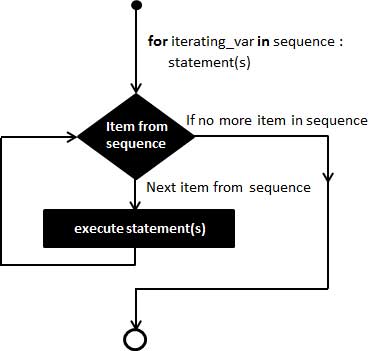A program by default follows a sequential execution of statements. If the program flow is directed towards any of earlier statements in the program, it constitutes a loop. The for statement in PHP is a convenient tool to constitute a loop in a PHP script. In this chapter, we will discuss PHP’s for statement.
Flowchart of “for” Loop
The following flowchart explains how a for loop works −

The for statement is used when you know how many times you want to execute a statement or a block of statements.
Syntax of “for” Loop
The syntax of for statement in PHP is similar to the for statement in C language.
for(expr1; expr2; expr3){
code to be executed;}The for keyword is followed by a parenthesis containing three expressions separated by a semicolon. Each of them may be empty or may contain multiple expressions separated by commas. The parenthesis is followed by one or more statements put inside curly brackets. It forms the body of the loop.
The first expression in the parenthesis is executed only at the start of the loop. It generally acts as the initializer used to set the start value for the counter of the number of loop iterations.
In the beginning of each iteration, expr2 is evaluated. If it evaluates to true, the loop continues and the statements in the body block are executed. If it evaluates to false, the execution of the loop ends. Generally, the expr2 specifies the final value of the counter.
The expr3 is executed at the end of each iteration. In most cases, this expression increments the counter variable.
Explore our latest online courses and learn new skills at your own pace. Enroll and become a certified expert to boost your career.
Example
The most general example of a for loop is as follows −
Open Compiler
<?php
for ($i=1; $i<=10; $i++){
echo "Iteration No: $i \n";
}
?>Here is its output −
Iteration No: 1
Iteration No: 2
Iteration No: 3
Iteration No: 4
Iteration No: 5
Iteration No: 6
Iteration No: 7
Iteration No: 8
Iteration No: 9
Iteration No: 10
An infinite “for” loop
Note that all the three expressions in the parenthesis are optional. A for statement with only two semicolons constitutes an infinite loop.
for(;;){
Loop body
}To stop the infinite iteration, you need to use a break statement inside the body of the loop.
A decrementing “for” loop
You can also form a decrementing for loop. To have a for loop that goes from 10 to 1, initialize the looping variable with 10, the expression in the middle that is evaluated at the beginning of each iteration checks whether it is greater than 1. The last expression to be executed at the end of each iteration should decrement it by 1.
Open Compiler
<?php
for ($i=10; $i>=1; $i--){
echo "Iteration No: $i \n";
}
?>It will produce the following output −
Iteration No: 10
Iteration No: 9
Iteration No: 8
Iteration No: 7
Iteration No: 6
Iteration No: 5
Iteration No: 4
Iteration No: 3
Iteration No: 2
Iteration No: 1
Using the “for…endfor” construct
You can also use the “:” (colon) symbol to start the looping block and put endfor statement at the end of the block.
Open Compiler
<?php
for ($i=1; $i<=10; $i++):
echo "Iteration No: $i \n";
endfor;
?>Iterating an indexed array using “for” loop
Each element in the array is identified by an incrementing index starting with “0”. If an array of 5 elements is present, its lower bound is 0 and is upper bound is 4 (size of array -1).
To obtain the number of elements in an array, there is a count() function. Hence, we can iterate over an indexed array by using the following for statement −
Open Compiler
<?php
$numbers = array(10, 20, 30, 40, 50);
for ($i=0; $i<count($numbers); $i++){
echo "numbers[$i] = $numbers[$i] \n";
}
?>It will produce the following output −
numbers[0] = 10
numbers[1] = 20
numbers[2] = 30
numbers[3] = 40
numbers[4] = 50
Iterating an Associative Array Using “for” Loop
An associative array in PHP is a collection of key-value pairs. An arrow symbol (=>) is used to show the association between the key and its value. We use the array_keys() function to obtain array of keys.
The following for loop prints the capital of each state from an associative array $capitals defined in the code −
Open Compiler
<?php
$capitals = array(
"Maharashtra"=>"Mumbai",
"Telangana"=>"Hyderabad",
"UP"=>"Lucknow",
"Tamilnadu"=>"Chennai"
);
$keys=array_keys($capitals);
for ($i=0; $i<count($keys); $i++){
$cap = $keys[$i];
echo "Capital of $cap is $capitals[$cap] \n";
}
?>Here is its output −
Capital of Maharashtra is Mumbai
Capital of Telangana is Hyderabad
Capital of UP is Lucknow
Capital of Tamilnadu is Chennai
Using Nested “for” Loops in PHP
If another for loop is used inside the body of an existing loop, the two loops are said to have been nested.
For each value of counter variable of the outer loop, all the iterations of inner loop are completed.
Open Compiler
<?php
for ($i=1; $i<=3; $i++){
for ($j=1; $j<=3; $j++){
echo "i= $i j= $j \n";
}
}
?>It will produce the following output −
i= 1 j= 1
i= 1 j= 2
i= 1 j= 3
i= 2 j= 1
i= 2 j= 2
i= 2 j= 3
i= 3 j= 1
i= 3 j= 2
i= 3 j= 3
Note that a string is a form of an array. The strlen() function gives the number of characters in a string.
Example
The following PHP script uses two nested loops to print incrementing number of characters from a string in each line.
Open Compiler
<?php
$str = "TutorialsPoint";
for ($i=0; $i<strlen($str); $i++){
for ($j=0; $j<=$i; $j++){
echo "$str[$j]";
}
echo "\n";
}
?>It will produce the following output −
T
Tu
Tut
Tuto
Tutor
Tutori
Tutoria
Tutorial
Tutorials
TutorialsP
TutorialsPo
TutorialsPoi
TutorialsPoin
TutorialsPoint
Leave a Reply